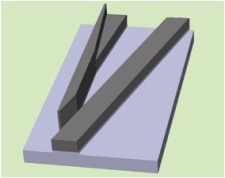Light Twister
The data-carrying light waves in optical fibers have either horizontal or vertical polarities. Both types of waves are easily processed in today’s millimeter-scale photonic devices, but polarization differences may lead to signal loss in future micrometer-scale devices on chips. This submicrometer structure from MIT’s Research Laboratory of Electronics can be etched into silicon. Light enters a waveguide and is split into horizontal and vertical components. Vertical beams are rotated to horizontal for processing and later recombined.

Keep Reading
Most Popular
Large language models can do jaw-dropping things. But nobody knows exactly why.
And that's a problem. Figuring it out is one of the biggest scientific puzzles of our time and a crucial step towards controlling more powerful future models.
How scientists traced a mysterious covid case back to six toilets
When wastewater surveillance turns into a hunt for a single infected individual, the ethics get tricky.
The problem with plug-in hybrids? Their drivers.
Plug-in hybrids are often sold as a transition to EVs, but new data from Europe shows we’re still underestimating the emissions they produce.
Stay connected
Get the latest updates from
MIT Technology Review
Discover special offers, top stories, upcoming events, and more.